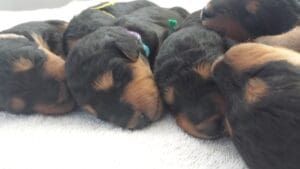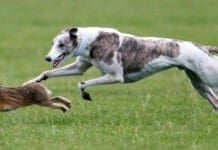There is no easy way to figure out when your young dog will go into heat for the first time and, other than surgical intervention ahead of time, there is no way to stop it from happening. Identifying what is typical for dogs of a similar breed and size can narrow down the timeline, but it will still only be an approximation. Any time between about 6 months and a year and a half is considered normal, though some smaller dogs may start as young as 4 months and some large breeds as old as 2 years.
If you haven’t been through a heat cycle before with a dog, it will help to learn what it looks like so you can recognize it when it happens. If in doubt, don’t be afraid to call your veterinarian for confirmation—a potentially silly question or the expense of an office visit is far better (and cheaper) than an unplanned pregnancy.
Signs your dog is in heat can include:
- bloody discharge from her vulva
- enlarged vulva
- licking genital area
- behavioral changes
- change in tail posture
- possible changes in mood, including crankiness

Given that I come from a family that has bred Airedales for decades, I understand the appeal of raising puppies. Not only are they adorable little bundles of potential, there’s something amazing about meeting the sons and daughters of a dog who is a beloved member of the family. The work it has taken to preserve and improve this very special line of dogs has been monumental—full of joy and loss, sleepless nights, and any number of difficult decisions.
That is, perhaps, why it almost always makes me cringe when I hear someone say, “I love my dog. I’m thinking of breeding her.” Most people, even well-intentioned ones, just aren’t prepared to make informed breeding decisions and raise puppies well. And it is the dogs who suffer for it.
As emotionally difficult as it can be for the humans involved, having a great personality does not make a dog a good breeding prospect. Alongside temperament, it’s important to thoroughly test and assess the health and abilities both parents. Ask yourself what you are trying to preserve and what it could look like if the puppies inherit only the least desirable traits—including any health issues—from the parents’ genetic lines.
Then there are the puppies themselves who require significant time, money, and care. Even if there are no expensive medical complications (like needing an emergency C-section), the best outcomes require understanding the canine reproductive process, good pre- and post-natal veterinary care, maintaining a safe and healthy environment for the mother and puppies, and knowledge of early development and training. At the risk of sounding harsh, if you don’t know how to properly cut an umbilical cord or glove up and assist if a puppy gets caught in the birth canal, don’t breed your dog. Yes, the majority of dogs can give birth by themselves, but your job as your dog’s caretaker—and the one who allowed her to get pregnant—is to be prepared if she and her puppies need help.
Finally, if you are thinking about breeding your dog, ask yourself if you are able and willing to provide a home for her puppies for the rest of their lives. I firmly believe that if we humans—accidentally or on purpose—bring a dog into this world, then we need to ensure he or she always has a safe place to go. Even following best practices for finding good placements for any puppies you’re not keeping, sometimes it doesn’t work out. It’s then up to you to bring the dog home, no matter how many years it has been.
What to Do When Your Dog is in Heat
Once a dog’s heat cycle starts, there are several things you will need to do. First, keep an eye out for anything unusual. While bloody or straw-colored discharge is normal, it should not be thick or mucousy. A discharge that is mostly mucous can be a symptom of a uterine infection (pyometra). This condition can be life threatening and requires immediate veterinary attention.
You will also need a plan for how to keep your dog away from any intact male dogs. Avoid spots where dogs might interact off leash such as dog parks or doggy daycare. Even if you have a fenced yard, she should not be left alone outside for any length of time. A fence—no matter how good—won’t keep a determined suitor out.
In addition, you will want some supplies on hand to handle the discharge. There is no way to stop a dog from bleeding when she is in heat, but there are some tricks to managing the potential mess. Most dogs will keep themselves clean, but if you have a long-haired or thick-coated dog, she may need some help. If the fur on her back legs or around her vulva is getting dirty, you can use a soft cloth dampened with warm water to clean her up. Be gentle—her vulva will be more sensitive than usual.
The amount of discharge during a heat varies from dog to dog and cycle to cycle. If it is on the heavier side, sanitary diapers can be used to keep the discharge from getting on floors and furniture. Dog diapers come in two varieties: washable and disposable.
In my experience, washable diapers often fit better but usually require a disposable pad to catch any leaks. Disposable diapers are great at absorbing discharge but can be a choking/swallowing hazard if your dog decides to remove hers and chew it up. Whichever you choose, be sure to change it regularly—every three to four hours—to avoid sores and infections.
For lighter discharge, you can often leave the diaper off in favor of covering your dog’s bed and usual hang-out spots with an old towel or potty pad. Again, be sure to change them out when they get dirty.
As discussed in “How to Comfort a Dog in Heat,” changes in hormone levels during the heat cycle can cause symptoms including clinginess, grouchiness, decreased appetite, and lethargy. You can help your dog by providing comfort, support, and in-home enrichment to keep her engaged when she can’t go out as much.
While spaying your dog is the best way to prevent pregnancy, it is generally not recommended when the dog is in heat. Most veterinarians will advise waiting to perform the surgery until at least three weeks after her cycle has ended to lower the risk of complications.
More On Heat Cycles
There are a few things it’s important to know when it comes to canine heat cycles:
- If your dog is in heat, assume she can get pregnant.
- Most unspayed female dogs have one to two cycles a year.
- Heat cycles usually run two to three weeks but can last longer.
- While bloody discharge and an enlarged vulva are typical, a dog can cycle (and get pregnant) without showing any external signs—called a “silent” heat.
For more information on how dog heat cycles work, see “How Long are Dogs in Heat?”.







Good article.
One thing you forgot to mention is that an intact male can smell a bitch in heat approximately 7 miles away. (Yes, I said seven.)
Many people I talk to say “oh, my neighbors dogs are all neutered”, maybe, but the one 3 miles away may not be.
Just a note of caution.
Kitti (DVM)